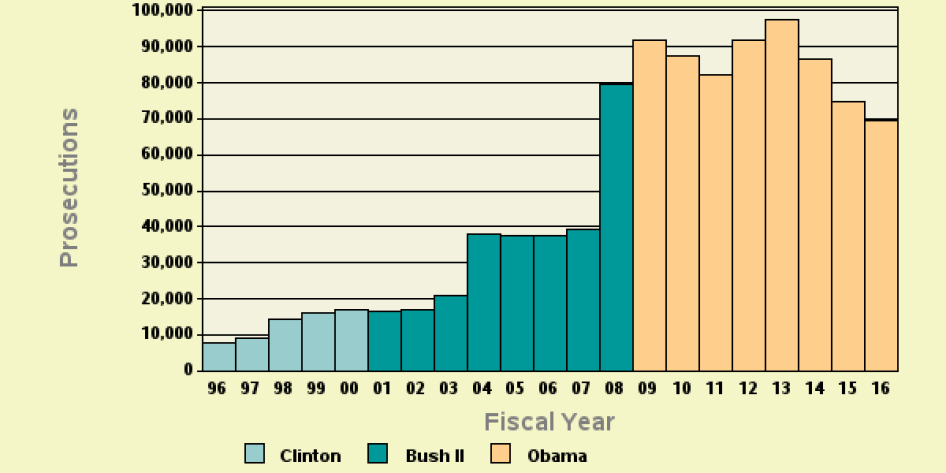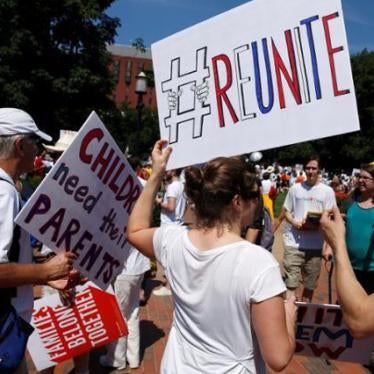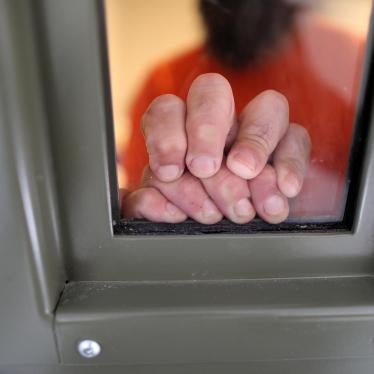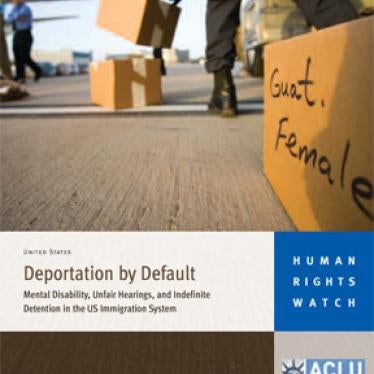On April 6, 2018, US Attorney General Jeff Sessions announced a new “zero-tolerance” policy intended to ramp-up criminal prosecution of people caught entering the United States illegally. Soon afterward, news outlets began to report that unauthorized immigrant parents traveling with their children were being criminally prosecuted and separated from their children. Altogether, nearly 3,000 children were separated from their parents before President Donald Trump signed an executive order on June 20 halting family separation. The order, however, stated that the “zero-tolerance” policy would continue.
The family separation policy and treatment of families coming to the US has generated considerable public attention and outrage. The “zero-tolerance” policy underlying this crisis and the abuses accompanying mass criminal prosecutions of immigrants, however, has received less attention.
Although this is the first time a “zero-tolerance” policy resulted in immediate separation of parents traveling with children, this is not the first time the US government has sought to ramp-up criminal prosecution of immigrants. Human Rights Watch research into the history of criminal immigration prosecutions in the US found serious human rights problems, even when families were not being separated at the border. The US government’s latest steps to additionally restrict eligibility for asylum, as well as its stated goal to prosecute 100 percent of those entering illegally, compound and multiply these harms.
The “Questions & Answers” below explain the ways in which the “zero-tolerance” policy under the Trump administration is both different from and similar to prior prosecutorial policies and why criminal prosecution of immigrants for illegal entry raises human rights concerns.
What is the Trump administration’s “zero-tolerance” policy?
How did the policy lead to family separations?
How have these offenses been prosecuted in the past?
In what way were immigration prosecutions already damaging to rights?
Do “zero-tolerance” policies deter illegal immigration?
What are the public safety and financial costs of “zero-tolerance” immigration prosecution policies?
Doesn’t the US government have a responsibility to regulate immigration?
What should the US government do as an alternative to criminally prosecuting migrants?
What is the Trump administration’s “zero-tolerance” policy?
The April 2018 policy directs US attorney’s offices along the southwest border to accept for criminal prosecution all cases involving illegal entry – that is, entering the US without authorization – referred to them by US Customs and Border Protection (CBP) “to the extent practicable.”
Since then, judicial districts along the southwest border have seen a significant increase in prosecution of immigration-related referrals by CBP. Among the five judicial districts on the border, in June 2018 there were 20 percent more immigration prosecutions than in May 2018, and 74 percent more prosecutions than in March 2018. There were also 134 percent more CBP-referred prosecutions in June 2018 than in June 2017.
Attorney General Sessions has declared the goal is 100 percent prosecutions of people caught crossing the border illegally. As of June 2018, 46 percent of adults arrested by Border Patrol were prosecuted. This represented an increase from May 2018, when less than one-third of adults arrested by Border Patrol were prosecuted.
How did the policy lead to family separations?
The Trump administration repeatedly emphasized that there was no “blanket policy” to separate families as a way to deter others, and that the family separation was a consequence of the “zero-tolerance” policy, combined with a federal court action limiting the detention of children, including in family detention. The government’s position seemed to be that the prosecutions required the parents to serve time in criminal custody, and thus due to rules on holding children in either criminal or immigration detention, the separations were the logical result.
However, as noted above, the “zero-tolerance” policy did not actually lead to prosecutions of 100 percent of adults apprehended at the border. The government specifically chose to prosecute parents traveling with children over adults traveling alone. This is in sharp contrast to the policy under previous administrations, under which parents traveling with children were rarely criminally prosecuted.
The Trump administration had stated more than a year earlier that it was considering separating families to deter them from entering the US. The administration also began separating families, including families who crossed the border legally, in October 2017, long before the “zero-tolerance” policy was announced in April 2018. Human Rights Watch has spoken with families who crossed the border in an unauthorized manner during the “zero tolerance” policy and were separated, but apparently not prosecuted. Family separation was therefore not an unintended consequence of the “zero-tolerance” policy but an effort to punish families.
The Trump administration has claimed it is merely enforcing existing laws. What exactly are the crimes being prosecuted? How long have these offenses been federal crimes?
The current “zero-tolerance” policy specifically refers to referrals for immigrants committing “illegal entry,” or entering the US without authorization. Illegal entry is a federal misdemeanor, punishable by up to six months in prison, with a subsequent conviction for illegal entry punishable by up to two years.
The other most commonly prosecuted immigration offense is “illegal reentry,” entering the US without authorization after previously being deported, which is a federal felony. The maximum penalty is 20 years, applicable if the defendant reenters after a prior conviction for an “aggravated felony” (a term covering both relatively minor and nonviolent offenses such as shoplifting or working with a fake ID, as well as serious, violent crimes). Lower maximum sentences apply to reentry after prior convictions for lesser felonies and misdemeanors.
Both offenses have been federal crimes since the early 20th century but the maximum sentence has increased over the years. Since 2015, there have also been efforts in the US Congress to create higher penalties, including mandatory minimum sentences, for these crimes.
How have these offenses been prosecuted in the past?
Although these offenses have been federal crimes for many years, for most of that time, the US government usually prosecuted people only if they had serious prior criminal convictions and had reentered after being deported, or if they were “repeat offenders” – people who had reentered repeatedly after deportation.
In 2005, a “zero-tolerance” program called Operation Streamline was implemented in Del Rio, Texas, to prosecute people with little or no prior criminal history, as well as first-time migrants. Operation Streamline, with slight variations in prosecutorial policies and procedures, was then implemented in other sectors along the southwest border, with the exception of San Diego. The current “zero-tolerance” policy has brought Streamline to San Diego for the first time.
After the advent of Streamline in 2005, the number of prosecutions for illegal entry and reentry began to soar.
As the graph from Transactional Records Access Clearinghouse shows, immigration prosecutions dropped after 2013 but remained significantly higher than before 2005. In 2016, even before the Trump administration announced its “zero-tolerance” policy, immigration prosecutions – the vast majority involving illegal entry and illegal reentry – constituted 52 percent of all federal criminal prosecutions.
As stated previously, even under these increased prosecutions, parents traveling with children were generally not prosecuted until recently.
If Operation Streamline was already in effect, how is Trump’s “zero-tolerance” policy different from prior policies?
To be clear, Operation Streamline and the accompanying increase in prosecutions of people for illegal reentry resulted in serious harm to families and asylum seekers, as well as to due process, long before this administration began its “zero-tolerance” policy. (See below.)
Under the Trump administration, however, the harms of these prosecutions have been compounded by increased prosecution, as well as by specific efforts to target parents traveling with children and to penalize asylum seekers for illegal entry, in violation of international law.
First, as stated above, the Trump administration for the first time systemically prosecuted large numbers of parents traveling with children, leading to unprecedented separation of thousands of families at the border.
Second, the “zero-tolerance” policy is coupled with new and serious barriers to asylum. Previous “zero-tolerance” polices led to the criminal prosecution of asylum seekers. The current administration’s policy goes further, explicitly targeting asylum seekers who enter illegally and issuing guidance to asylum officers directing them to consider illegal entry a factor that they may count against an individual’s application for asylum.
In what way were immigration prosecutions already damaging to rights?
The procedural shortcuts necessitated by the breadth and scope of criminal prosecutions for illegal entry and reentry imperil the due process rights of immigration defendants. In Operation Streamline, the stages of a federal criminal court case that normally take months are truncated into a single day, sometimes less, as dozens of people, sometimes even more than 100, are charged, plead guilty, and are sentenced together in a matter of hours. While all defendants are appointed a defense lawyer, the amount of time they spend with their attorney before they plead may be as little as 5 to 10 minutes.
Criminal prosecution in and of itself as punishment for seeking asylum violates international refugee law. Prosecution also places obstacles to obtaining refugee protection, exacerbating trauma or psychological problems, and potentially discouraging people from pursuing asylum claims. The Refugee Convention states that countries should not penalize asylum seekers, including those whose applications are still pending, for entering without authorization, if they present themselves without delay to authorities and show good cause for the illegal entry.
Human Rights Watch research shows criminal prosecutions also affect long-term US residents who are trying to return to US citizen family members after deportation. US immigration law currently fails to adequately protect families, as the right to family unity is not given adequate consideration in deportation decisions. As a result, criminal prosecutions can subject deported family members to prison time for trying to reunite with loved ones. Judge Robert Brack, who has presided over tens of thousands of immigration cases in New Mexico, told Human Rights Watch, “For 10 years now, I’ve been presiding over a process that destroys families every day and several times each day.” Thus, although the administration has technically ended its policy to separate families, the ongoing criminal prosecutions themselves continue to devastate families.
Who is being prosecuted?
Under the current and earlier “zero-tolerance” policies, criminal prosecution is not reserved for those with serious criminal histories. Even organizations that advocate for increased immigration enforcement acknowledge that many of the people who are criminally prosecuted today for illegal entry are not dangerous criminals, but “regular folks, dishwashers, landscapers.”
The change in the criminal histories of people prosecuted for felony reentry is particularly dramatic. In 2002, about 50 percent of people sentenced for illegal reentry had convictions serious enough to be counted in Criminal History Categories IV-VI (a categorization used in US Sentencing Guidelines). In 2017, with over twice as many people sentenced, only 24 percent of people convicted of reentry had convictions in these most serious categories. As more people have been prosecuted, fewer of them have had serious criminal histories.
As a result, the US government has prosecuted people with no prior criminal histories like Rosa Manriquez, a grandmother who had lived her entire life in the US, who was desperate to return to her citizen children and grandchildren; and “Brenda R.,” a mother who fled Mexico when police warned her to stop investigating the murder of two of her sons.
As prosecutions increase under Trump, even fewer people are likely to have serious criminal histories.
Do “zero-tolerance” policies deter illegal immigration?
In announcing the new policy, Attorney General Sessions declared such prosecutions were necessary to address a recent increase in apprehensions of immigrants at the southern border, and that Operation Streamline has worked in the past. Several studies and Human Rights Watch’s own research, however, cast doubt on those claims. A recent report by the Vera Institute of Justice analyzing CBP apprehension data before and after the advent of Operation Streamline in 2005 found that the decline in border crossings seen after Streamline was “part of a longer downward trend that had started several years earlier.” The Office of Inspector General at the Department of Homeland Security in 2015 also found CBP’s data was insufficient to support its claim that Streamline led to decreased border crossings.
Human Rights Watch research shows that many of the migrants who enter or reenter the US unlawfully do so for reasons often unaffected by traditional notions of deterrence, such as the desire to reunite with family in the US or to flee violence and persecution. As an assistant federal public defender in Los Angeles told Human Rights Watch, “The motivations for committing [illegal reentry] are not the motivations for committing most other crimes.”
The efficacy of deterrence hinges on an individual immigrant understanding what they have experienced. The experience of criminal prosecution and the experience of processing in the civil immigration system are now increasingly similar.
People who are prosecuted for illegal entry are brought into a courtroom and sentenced to time-served, from a couple days to a week, the time they have been in US Marshals custody awaiting sentencing. They are then turned over to the custody of Immigration and Customs Enforcement (ICE) for deportation. If they are seeking asylum because they fear for their life or liberty back home, and are appropriately screened and identified as asylum seekers, they will be held in immigration detention while they start the asylum application process. Depending on the case, they may be eligible for release or may be detained for months or years, sometimes subject to their ability to pay tens of thousands of dollars as bond. Otherwise, they are deported shortly after criminal prosecution and sentencing.
Immigrants who are not criminally prosecuted but are placed in the civil immigration system are held in detention centers that are similar to prisons, or in some cases, are actually federal prisons. Immigrants are often detained for months or even years and they also appear in immigration court.
The idea that criminal prosecution would seem like a unique and additional punishment is undercut by the punitive nature of immigration detention.
What are the public safety and financial costs of “zero-tolerance” immigration prosecution policies?
“Zero-tolerance” policies require enormous resources from federal prosecutors and courts, the Department of Justice, the US Marshals, and the Bureau of Prisons. In 2011, the chief judge of the US District of Arizona declared a judicial emergency in part due to the strain of immigration cases. A 2012 report estimated incarceration costs alone for those sentenced for illegal entry and reentry reached $1 billion in 2011. Individuals serving sentences for illegal entry and reentry are an important source of the burgeoning federal prison population. The number of people serving prison sentences for immigration offenses grew 762 percent from 1990 to 2015.
Prosecutors and other law enforcement officials have also noted that criminal prosecution of unauthorized immigrants with minor or no prior criminal histories has diverted resources from more pressing law enforcement and border security concerns. A bipartisan group of 70 former US attorneys wrote a public letter to Attorney General Sessions criticizing the policy and declaring, “[T]he time a Department attorney spends prosecuting misdemeanor illegal entry cases, may be time he or she does not spend investigating more significant crimes like a terrorist plot, a child human trafficking organization, an international drug cartel or a corrupt public official.” According to the Transactional Records Access Clearinghouse, the recent increase in immigration prosecutions along the southern border has been accompanied by a decrease in prosecutions of other federal crimes.
The Trump administration’s decision to prioritize low-level immigration offenses is in keeping with the historical trend of the last two decades to conflate unauthorized immigration with serious threats to public safety and national security. According to the nonpartisan Migration Policy Institute, in 2012 the budget for immigration enforcement (CBP, ICE, and US-VISIT) was $18 billion—about 24 percent more than the total budgets combined of the Federal Bureau of Investigation (FBI), Drug Enforcement Administration, Secret Service, US Marshals Service, and Bureau of Alcohol, Tobacco, Firearms and Explosives. It is in this context that the Trump administration has sought significant increases in funding for federal prosecutors specifically for immigration enforcement, as well as an unprecedented level of immigration detention capacity and other deportation resources.
Doesn’t the US government have a responsibility to regulate immigration?
All sovereign states have a legitimate interest in regulating entry into their territories, and particularly in deterring the illegal entry or reentry of non-nationals who pose a threat to public safety. But the prosecutions of illegal entry offenses are overbroad, especially when one considers that immigration authorities already have the power to deport unauthorized immigrants. Prosecutions are thus draining resources that could go to efforts to increase public safety and create a more secure, efficient, and humane immigration system.
What should the US government do as an alternative to criminally prosecuting migrants?
The US immigration system should be overhauled to better protect immigrants’ rights to seek asylum, to family unity, and to due process. Among other steps, the US government should:
- consider ending the penalization of illegal entry and reentry as criminal offenses, and instead treat them as violations of civil law with ensuing civil penalties such as deportation, when warranted;
- cease authorizing, funding, or expanding Operation Streamline and similar programs that facilitate mass prosecutions and undercut due process rights of those charged with illegal entry offenses;
- end the prosecution of asylum seekers and adopt national guidelines for the exercise of prosecutorial discretion in cases in which defendants have extenuating circumstances, such as ties to US family members;
- adhere to the new policy against family separation by keeping families with children together and desist from detaining such families. Pursue instead alternatives to immigration detention for families and other immigrants, such as community-based case management programs, which have been successful in the US and in other countries in ensuring immigrants appear in court, leaving immigration detention as a last resort.










